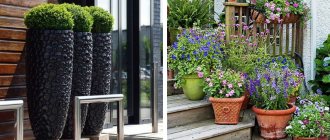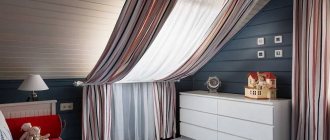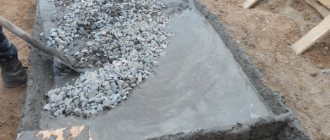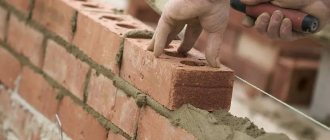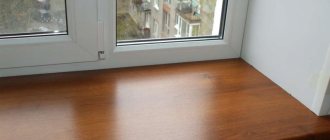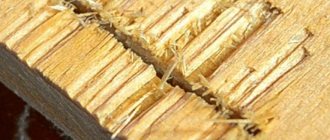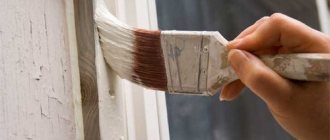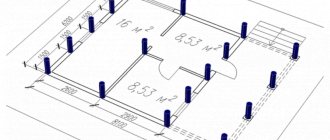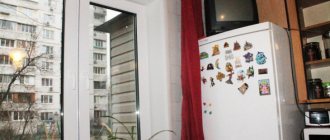Decorating your home interior or local area is an exciting activity. Some people hire professional designers to do this, while others like to do it themselves. But everyone wants to arrange their personal piece of the planet in a non-standard, original and beautiful way. Concrete can be very helpful in this matter - the material is accessible, inexpensive and very plastic. Paving and facing tiles, flower beds and flowerpots made of cement can decorate the garden, and flower pots, vases and other decorative vessels can transform the interior. They are not difficult to make, and in this article you will find some interesting ways.
Anyone can make such floor vases Source na-dache.pro
What will you need?
Of course, each craftsman has his own set of components from which he prefers to make garden flowerpots. As for the optimal or universal option, the work most often requires:
- gray cement or white Portland cement grades M 400 or M 500;
- sifted and washed fine sand;
- clean or settled water at room temperature;
- color for concrete or a special dye for it;
- container for mixing the working solution;
- electric drill with mixer attachment;
- drill for drainage holes;
- polyethylene film or release grease (solidol);
- form for a future vase;
- fabric (kitchen or terry towel, jute burlap, tulle).
In addition, depending on the type of model, you may need ties, with which you can give the future vase a special shape. The prepared container for diluting cement must be clean and grease-free
It is also important to take care of the cleanliness of the workplace, for which it is worth preparing any covering material (old cardboard boxes or the same thick film, used large-sized plastic bags will do)
As for the material of the mold for the future vase, it can be different. A metal bucket, an old flower vase, or even a plastic basin will do. Some people use rectangular containers for seedlings, as well as cardboard boxes, to make garden cement flowerpots. At the same time, sometimes such bases are specially crushed to obtain a more unusual shape. You can use anything that can be easily removed later, separating the frozen fabric and the form.
Modern trends in landscape design
Landscape designers agree that concrete flowerpots give special presentability to the owners of a garden, dacha or cottage. Bowls for flowers both decorate the area and serve as a practical platform for placing green plants almost anywhere. Trends in decorating local areas require flowerpot owners to make containers made of materials that closely resemble natural materials.
Decorating lawns from natural stone is too difficult and expensive. A practical direction in their creation is the use of materials for a monolithic composition: concrete and cement.
Design artists find concrete planters especially functional.
With the help of such massive bowls:
- a special aura of a suburban or urban local area is born;
- Concrete flowerpots zone the space and collect its details into a single picture.
Massive vases are actively used by decorators in private households, parks, squares, at the entrance to cultural sites, as well as in administrative buildings.
- environmental friendliness and mobility: plants grow excellently in such flowerpots; for capricious flowers, you can choose an exclusive place to install the bowl;
- outdoor flowerpots can be made in the style preferred by the customer (from modern to classic);
- Concrete can be painted and finished, so flowerpots can be easily decorated in any color scheme.
Conclusion
In general, it is quite possible to make not only an “eternal”, but also an exclusive flowerpot yourself. Concrete, a little ingenuity and imagination and years of admiring not only the content, but also the form.
In recent years, the loft style has become increasingly popular, and with it concrete, not only in gardening, but also in the interior. Concrete makes excellent functional and very original furniture. No less interesting is a material such as tadelakt - it is not only the oldest type of plaster, but also an excellent material for covering concrete sinks. The video shows the first experience of landscape design.
Subscribe to our Telegram channel Exclusive posts every week
Making a vase from concrete
Ready-made cement structures can be easily bought in the store, but we will make concrete vases with our own hands. All you have to do is decide what shape you want to make and prepare the material.
Forms for pouring concrete
You can choose any mold that you like. When choosing a mold to pour, decide what element your finished decor will be. What forms are there:
- from a plastic or glass bottle;
- made of cardboard or wood;
- from a disposable cup;
- from fabric.
Concrete vase can be made from miniature molds, all the way up to tall pots.
Tools and materials for concrete pots
The next step is to prepare the material and tools. You can buy all the components for working with concrete at any hardware store.
What you need to prepare for work:
- cement, preferably grade M-400 or M-500. You can also use a ready-made cement-sand mixture;
- ordinary quarry sand;
- fine crushed stone 5-20 mm;
- water;
- frame (mold for filling);
- gloves and spatula;
- container for mixing concrete;
- film.
Step-by-step instruction
We have prepared the main tool, we have learned what forms there are, and now let’s proceed to the step-by-step instructions on how to make a vase from cement:
- mix cement, sand and crushed stone with the addition of water. The ratio of cement and sand should be 1 to 3, and crushed stone - 25% of the total mass. Mix the whole mixture well. You can also use a cement-sand mixture or ready-made concrete B 25 with the addition of water;
- Cover one part of the mold with film so that at the end of the process it is easy to separate the frame;
- pour the made concrete onto the bottom of the mold, the layer should not exceed 4 cm;
- then level the layer with a spatula;
- use a regular metal pin or fittings as a drainage tube;
- Attach a second form to the tube, which serves as a weight. Load crushed stone or sand into it;
- after – pour the mixture between the frames and level the mass with a trowel (spatula);
- when you finish the concreting process, until the concrete sets completely, you need to spray it with water from a spray bottle and cover the form with film;
- After your vase is dry, remove all unnecessary frame elements. Do this very carefully so as not to damage the concrete.
The entire concrete drying process can last for two weeks. While your mold is drying, you can make several of these elements. We hope that our method will be useful to you to make concrete vases with your own hands.
Vivid examples
There are a lot of ideas and unusual examples. Refined natures will appreciate a flowerpot in the shape of palms. They do it as follows. You need to fill latex gloves with the solution. Then, before they harden, you need to give them the shape of hands that carefully hold the flowers.
Hungarian technology also has its fans. It is as follows. The forms are plywood templates with a semicircular recess and wire loops on the sides.
Proceed as follows:
- A mixture of cement and sand is poured into the center of a sheet of roofing felt or plywood. It is necessary to mix everything thoroughly and form a slide. A hole is made in it, into which water should be carefully poured.
- You need to immerse the template rod into it. This is how the internal walls are created. The rod is rotated in the same way as professional potters work. The mixture produces a hemisphere. A film is placed on top. Then mix again. Then a metal mesh. There is another layer of solution on it.
- Finally, you need to use the second template. It will support the outer walls of the future masterpiece. You will create an amazing fantasy structure that will be completely different from heavy cement monuments. Now you can pull out the rod and wait until the product dries well.
- If you think that the flowerpot looks plain, you can decorate it. Painting with acrylic paints will look stylish. Staining concrete is very easy. It is only important to thoroughly prime the entire surface and only then apply painting. Also, don't be too zealous in terms of palette. It is important that the decorations do not dominate in color over the flowers that you will grow in this container.
To make the surface shimmer in different colors, you can decorate the flowerpot with a mosaic. Pieces of tiles can act as mosaics. A thick layer of glue is first applied to the flowerpot. Then the tile pieces are distributed. In this case, each element is pressed into glue.
The same method is suitable for decorating a flowerpot with pebbles.
In this case, it is important to be careful. It is necessary to immediately clean the pebbles from glue. If it dries out, it will be impossible to clean them. In order for the surface to look elegant, the gaps must be rubbed after the glue has dried. Flowerpots with mosaics in Indian or Byzantine style look very stylish.
Necessary tools and mixtures
For the work process that is carried out in the summer, you will not need many materials if you decide in advance on the appearance, think through the raw materials, decor and frame. Depending on the specific case, cement, sand or a ready-made mixture are used. Water and the composition should always be at hand: sometimes the composition turns out to be dense, so it needs to be brought to the desired consistency
If the sand is not uniform, you may need a special sieve for the job. It is preferable to choose cement of at least M-400. This composition will work well and will not cause difficulties during the work process. In addition to this, you may need:
- polyethylene film;
- frame raw materials (what will serve as the basis or form);
- ready-made stencils, anti-stencils;
- gloves, spatula;
- metal pipe (for drainage);
- container for mixing concrete;
- non-stick spray (VD-40 grease or motor oil);
- paints and brushes, as well as a knife for cutting and adjusting the pattern.
Some home craftsmen even use tile adhesive left over after laying wall or floor tiles. Due to perfectly balanced proportions and homogeneity, this material mixes well with other components without forming lumps.
Everyone chooses their own finish: it is enough for one to decorate the surface with pebbles of different shapes, leaving the dominant place for decoration to fresh flowers. Others undertake work to demonstrate design skills, decorating the surface with carved patterns, for example, in an Indian theme. At the same time, plants in this tandem look no less stylish.
How to make: step-by-step master class
The steps will depend on how big the pot you decide to create. Let's look at a specific example.
For a large product, you need a plastic mold with parameters of approximately 53 cm in diameter and 23 cm in height. The solution is made up of white cement, perlite (agroperlite) and peat in a ratio of 2: 1: 2. A one and a half liter ladle can serve as a measuring container. Dilute the mixture with water until a thick mass is obtained.
This is a heavy lawn, it is better to do it right away in the place where it will stand permanently. Keep the plastic mold (inner) ready. Place a solution 4-5 cm thick on the bottom (easily measured with a toothpick). We install a wire frame for strength. Due to the size of the container, four to five batches of the cement composition will be required.
We insert a plastic pot wrapped in cellophane film into the first mold and straighten the folds. Place the solution around the pot. It is necessary for such a bulky structure to dry completely (it will take at least 8 days). Then the flowerpot is removed from the mold and treated with a brush. Rinse and dry again. Cover with damp burlap or a piece of cloth and leave to harden further until the material acquires a light shade: this is a sign that the bowl is ready.
You can make a small concrete flower pot for the garden with your own hands using cement mortar and an ordinary rag.
The sequence of actions is as follows:
- Old towels or any thick fabric work well as fabric. Use an old bucket for the initial form (be sure to wear gloves on your hands).
- Turn the cement into a creamy consistency. To dry the flowerpot, turn the bucket over and cover it with polyethylene, otherwise you won’t be able to remove your product.
- Dip a towel or rag into the container with the solution until it is completely saturated. Then take it out and straighten it.
- Place a towel in cement on an inverted bucket and smooth the bottom. What is now the bottom of the bucket will later become the bottom of the vase. Let the folds hang down; you can give them any shape you want.
- The fabric with cement dries in this form for two days. Take the bucket out from under the frozen flowerpot: here you have the simplest flower girl.
Available materials
In principle, almost anything can be a variation of a flowerpot; you just need to take a close look at the objects that surround you. Old watering cans, tins of cookies that were eaten long ago and with gusto, an old chandelier and even wooden clothespins will do.
If you have nothing at all (for example, you recently did a particularly extensive spring cleaning), don’t worry. Even from ordinary flower pots you can make a wonderful artistic composition if you add a little imagination.
We make beautiful flowerpots from fabric and cement for the garden and cottage
To make flowerpots or flowerpots you will need:
- Cement (for a high-quality solution, it is advisable to add fine gravel and expanded clay, as well as a little sand),
- Pieces of fabric or old towels (waffle or terry)
- Container for mixing the solution and water
- A bucket or other container for drying the pots (to give it the desired shape),
- Paints, brushes and decorations
Let's start working on the flowerpots.
First you need to prepare a cement solution. It is better to do this in seals.
In order for the mixture to be of high quality and the flowerpots to turn out beautiful, the following proportions must be observed: mix 2 parts of sand and one part each of cement and gravel. The gravel should be fine (from 3 to 7 mm), but if you want the flowerpots to be lighter, some of the gravel should be replaced with fine expanded clay.
Gradually add water to the dry mixture; the consistency should resemble liquid sour cream.
Wrap the bucket on which the flowerpot will dry with polyethylene so that nothing sticks to it.
Dip the selected piece of fabric or towel into the solution. It needs to be completely saturated with cement. Then we take it out and straighten it.
We lay the fabric on a bucket standing upside down and straighten the folds so that it is beautiful. The bottom should be smooth, as shown in the photo:
The flowerpot will dry for about 2 – 3 days. After this, it can be removed from the mold, painted and decorated to your liking.
Beginning of work
In order to start working on a flowerpot, you must first create a drawing of the future product. After this, you can cut out a shape based on it, which will be determined by the prepared template or the one you created yourself. The workpiece is glued together. To make it durable, the entire surface is coated with glue.
- Initially, a composition of a certain consistency is prepared. It is important that the solution does not spread. To do this, take two parts of cement and 3 parts of sand. Add a little water to them. All components are thoroughly mixed until smooth.
- Once the mixture is ready, you can pour it into the mold.
- If you suddenly want to create a luxurious garden bowl from washed concrete, it is important to take into account the specifics of this material. Washed concrete contains naturally occurring stone. These are travertine, marble chips, quartzite, granite crushed stone and pebbles. It also contains artificial components. These are cast iron shot, smalt, glass chips.
It will be possible to create a durable and very beautiful texture.
But this can only be achieved through certain manipulations.
A mixture of concrete with the additives we listed above is placed in a mold. The half-hardened product must be removed and the top layer washed under water pressure. Cement. the sand will leave, the stone will appear.
It looks very unusual. But it is better to implement such an idea with professionals. You will create a product that is unique in color.
Flowerpot manufacturing technology
- For convenience and the ability to remove the product, the mold under the flowerpot is carefully covered with stretch film.
- Preparation of cement mortar. Before preparing the cement mortar, a fabric blank is placed in the container. A mark is made on the inner wall to indicate how much space it takes up. The workpiece is removed. Pure water is poured into the container “to the mark” or slightly above the mark. Cement is added to the water while simultaneously stirring the mixture with a mixer attachment. Cement is added until a consistency between milk and sour cream is achieved;
- When the cement lait is ready, dip a cloth into the container and allow it to be thoroughly soaked in the mixture. Before removing, you should make sure that there are no dry areas left on the fabric;
- The workpiece is removed from the container and thrown like a rag onto an inverted bucket. Having learned “the wings-walls of the pots are carefully laid out in beautiful folds, and the fabric on the bottom is carefully straightened so that there are no folds;
- After three days, the pots are removed from the mold and painted with concrete paint from the above list.
Do-it-yourself cement vases in your summer cottage should look natural, in accordance with nature; they should be somewhat different: natural, monolithic. In other words, the material of such products should be close to natural, be appropriate - rough and inexpensive. A cement vase perfectly meets all these requirements. You can grow both annuals and flowers in it, which will delight you with their blooms for many years. Plants in such cement creations can be left in the rain. It’s not difficult to bring this idea to life by making everything out of cement with your own hands.
Materials and tools for work:
- cement, sand, water, stones;
- carton boxes;
- plastic bottles;
- scotch;
- container for mixing cement mortar;
- spatula for working with concrete.
Scheme for preparing cement mortar.
- They come up with a design for a future product. Cut off the excess part of the plastic bottle. The design is transferred from the head to cardboard. The latter is formed into the required shape by gluing the joints with tape. They glue on the folds and corners with special care, making sure that there are no gaps left.
- When the molds for pouring are ready, they proceed to making the mixture. The cement is poured with water (in the proportions indicated on the packaging), some stones and sand are added. The mixture is not too liquid, but not very thick - medium. Such that it flows, filling the space between the forms.
After mixing well, begin to pour into a cardboard form. The mold is filled approximately halfway with the solution. Immerse a second, smaller plastic container in the solution. Lower it so that a small bottom remains (about 2-3 cm).
After installing the second form into the solution, it is pressed down with a weight. This is necessary so that under the pressure of concrete the plastic does not rise upward, which is completely undesirable. Leave until morning. In the morning, take out the plastic form. Do not touch the cardboard container until the concrete is completely dry. And one more nuance: until the solution has completely set, drainage holes are drilled from the bottom. The future vase is placed in the sun and dried for several days.
After the product has dried, get rid of unnecessary cardboard. The vase is either left as is, which is very harmonious in color with the existing landscape, or painted in the desired color. How do they do it?
Old shoes
This option is one of the most convenient, since shoes, by their design, are initially an improvised container. Just remember that a planter and a pot are not the same thing, so you shouldn’t pour soil directly into your grandfather’s shoe. Let it be just a frame. When choosing a suitable pair for a flower pot, focus on the plants that will live there in the future - the higher the shoe, the more flexible or curly the flowers should be.
The ideal solution would be rubber boots - as they say, they will endure anything and they won’t mind any moisture. With this type of flowerpot, the main thing is not to get carried away, otherwise, in the heat of designer imagination, you risk being left without shoes.
Composition of the mixture for concrete grating
To obtain openwork concrete flowers of sufficient strength, we use the same composition of fine-grained concrete, but with the addition of polypropylene fiber. Fiber length 10-15 mm. The recommended amount is about 0.05% by weight of the mixture. This is approximately one or two pinches, but if desired, you can weigh it more accurately. You need to add it at the very end of the kneading and finally mix it together with the fiber for another 5-10 seconds.
Concrete flowers in test castings were made of different thicknesses (0.7 and 1.5 cm) and with different amounts of black pigment (1-5%).
After 7 days, each casting was subjected to strength testing using a hammer and pliers. This is far from professional measurements, but gives a very clear idea of the difference in the quality of the samples.
Naturally, as expected, the sample with a thickness of 1.5 cm and with the least amount of introduced pigment turned out to be the most durable. The remains of the samples after testing can be seen in the photos below.
Since the main purpose of using an openwork lattice of flowers is not as a load-bearing structure, but as a decorative overlay, special strength is not required. But, if you make the thickness larger, then the gratings can be used as separate elements.
Concrete flowers will look good on the walls of garden flowerpots made from colored concrete using the usual “box-in-box” method, as well as on concrete stands near benches and other small architectural forms in the garden.
Concrete flowers can easily be glued to the supporting structure with ordinary cement adhesive for exterior use. You can purchase it at a hardware store or make it yourself. How to prepare the adhesive composition yourself will be discussed in the following articles.
No title. Discussion on
Principles of a Natural Diet
1. Limit meat consumption . Reduce meat consumption to 1 time per day. This will reduce the level of toxins that poison the body.
2. Don't overeat . When eating, do not fill your stomach completely, that is, do not overeat (when you get up from the table, you should want to eat a little more). Remember, overeating is one of the causes of many diseases, especially the gastrointestinal tract.
3. Before lunch and before dinner, eat raw salads , in summer and autumn, from cucumbers, tomatoes, herbs; in spring and winter from carrots, beets, cabbage, apples, grated on a coarse grater. Add lemon juice or vegetable oil to the salad - 1 tbsp. spoon. The functioning of the stomach and intestines improves.
Creating a print
For manufacturing you will need the same material that was used in the glossy product. To create a print, you need to take printed fabric with various patterns, wallpaper or newspaper.
The cardboard is laid on a flat surface, a film is spread on top, then the location of the print is marked, taking into account that the form will be in the center. The location of the pattern is generously lubricated with silicate adhesive, fabric, newspaper or wallpaper is placed on this area, the outer side is placed on the film, and the inner side is connected to the fabric.
The inner side is also generously lubricated with adhesive; this work can be done while the main fabric is soaked in cement. Leave space for up to 10 minutes for complete impregnation, while ensuring that small folds do not form.
A rag soaked in the mixture is spread on the foam, a bucket or other prepared form is placed in the central part, then it is turned over so that the fabric remains on top of the container. Beautiful edges are formed and left until completely dry, then the product is removed. To create a product with a bright and colorful color, white sand and the same cement are used, and the necessary pigment is added. It is worth considering that such materials may be more expensive than conventional standard types.
You can trim the edges with a simple hacksaw, but the cuts will stand out from the main color, so they are sanded with an emery mesh for plaster.
Antique decor
Such a flowerpot can look very original; for this you will need to create an artificial aging effect reminiscent of the shabby chic style.
You will need:
- any flower pot;
- alcohol-containing liquid;
- sandpaper - grit 70 and 100;
- moisture-resistant putty;• acrylic paint.
Stages of work
- wipe the flower pot with an alcohol-containing liquid to clean it well, then sand the surface with sandpaper;
- cover with putty and let it dry;
- Apply paint on top (in the photo below it is pistachio color, but you can choose another), when it dries, sand it again with sandpaper.
Photo source: www.tutknow.ru
How to make
If the method using a rag and mortar was chosen to create a vase, then everything is quite simple. However, before you start mixing the solution, it is better to carefully study all the stages and watch the master class.
How to make a concrete vase using fabric:
- Wrapping the mold with plastic wrap (it will make it easier to separate the product from the base)
- Installing the form on the workplace (firmly and reliably)
- Preparing the fabric, lowering it into the solution, thoroughly impregnating it
- Laying textiles on top of the mold so that the edges of the fabric hang evenly on the sides, forming neat folds, gartering with cords or ropes until the solution sets
- After the fabric has dried, it is separated from the mold, holes are made for drainage in the bottom and decorated
When creating flowerpots from cement, you should make sure that the forms are on a hill and the edges of the fabric hang freely. But if desired, the edges can be made rounded, placing them around the container on the ground in the form of folds and flower petals.
If lace is chosen for work, it is better not to make folds. Textiles without texture look more advantageous if they are beautifully straightened. By twisting the fabric, you can make diagonal folds.
You can use anything as a form - even a square or round tabletop, any object. While the concrete is drying, it is advisable to moisten it with cool water; the process usually takes 1-3 days. After removal from the mold, the product is still dried and processed with sandpaper.
Vases for the dacha are made from two molds and burlap: they take two containers of different sizes, place a smaller one on the bottom of the larger one, pouring cement mortar inside the edges. When the mixture dries, the mold is taken out and decorated with cement-impregnated burlap and coarse knots.
If you don't have a mold, you can learn how to make concrete vases using a method similar to pottery.
Making a vase for a garden without a mold:
- Creating a template from plastic or metal - an iron pin and a piece of material attached to it
- Inserting a pin into a wooden base so that it does not change its position when rotating
- Fixing the template, rotating it along the sand slide until a flat surface is formed
- Filling the sand mold with mortar, leveling with a trowel
- Rotate the template around its axis, pour the mixture onto the surface
- When the vase is perfect, you can add clean cement mortar (without sand) and bring the product to the desired look
- Cover with plastic wrap, spray with water, wait for drying time
- When the product is dry, you need to pour out the sand and clean the inside of the vase
A beautiful concrete vase (flower, small) can be made from a bottle. Here the sequence of work is as follows: take a glass bottle with a wide neck or cut off the bottom from a plastic one, close the bottles, make holes in them for an object (a candle, pencil or test tube that will be inserted into the thickness of the concrete and make space for flower stems), make liquid concrete mixture, pour concrete into bottles, insert the selected object, knock to remove air.
After the concrete has stood for a day or two in the container, it needs to be emptied (carefully break glass through a cloth or cut plastic), remove the middle, dry it and use it.
Using the same principle, vases are made from cardboard boxes and various containers, filling them inside and inserting various objects to create space inside.
graceful caterpillar
To make a caterpillar, casting molds are not required. You can get by with plaster, water, acrylic paints, a brush, varnish and sandpaper. Only in this case the gypsum mixture must be made very thick and in small portions, so that it is enough for one link.
Each link is rolled by hand to form a ball. For ease of work, when the plaster sticks to your hands, put the workpiece aside, wash your hands and wipe them as dry as possible. Then they continue to roll out the ball. At the moment of hardening, it is lightly pressed down, making a flattened shape, and set aside to dry completely.
Three links must be made with a bevel in one direction - they will serve as a tail. For the legs, several links are made 3–4 times smaller than the main large links. After the workpieces have completely dried, they are treated with sandpaper, removing all sharp parts and polishing the surface.
The next stage is gluing all the links. Using Moment glue, connect the two links, allowing time for the glue to dry. Only then do they move on to the next workpiece; there is no need to rush. The joints of the links are coated with plaster on top and allowed to dry. The same applies to the caterpillar legs.
Using a sponge, green acrylic paint is used to cover the entire body of the workpiece twice, making its abdomen and legs a little lighter. Using a thin brush, the “face” of the cheerful caterpillar is painted. Finally, the product is varnished up to 6 times.
Gypsum caterpillar
How to decorate your vase?
If you like the idea of making decorative flower pots and definitely want to build such flowerpots for the garden, you can safely get to work. Handicrafts always attract a lot of attention; you can proudly show them to friends and acquaintances. But sometimes you want something more unusual or bright. You can decorate homemade flower beds the way you want.
For example, you may not like the rough outer surface of a homemade flowerpot. You can turn it into glossy after a little modification. To do this, when preparing the mixture, choose cement and sand of fine fractions or add Rotband dry plaster to the mixture. To dilute the mixture, use silicate glue instead of water.
Polyethylene is used to form a glossy surface. The following additions to the basic manufacturing method will be needed:
- 1Get a large thick piece of cardboard. Lay greenhouse covering material on it and straighten it so that all folds are smoothed out.
- 2After soaking the fabric with the solution, spread it on cardboard and smooth it well so that the towel adheres better to the surface.
- 3Then the bucket chosen to create the shape is placed in the center, after which the entire structure must be carefully and very quickly turned over, while holding it by the cardboard. The fabric should stick to the bucket along with the film.
- 4Form the folds of the future product to your liking. You cannot make deep creases - it will be difficult for you to get the film out of them. From the already frozen structure, you can try to burn out the pieces of film stuck there with a lighter.
The desired gloss has been achieved, but the product still has some minor defects. How can this be fixed? Take a brush and coat the dried vase with silicate glue without diluting it. This way you can hide all the defects. You can additionally add paint to the adhesive composition - this way you will get a pot of the desired color and add shine to its outer surface.
Decorative flower pots with horse figurines: photos, descriptions, diagrams
For a flowerpot in the shape of a horse you will need:
- Rounded log cuts – 4 pcs. Of these, 2 saw cuts are large and 2 are smaller
IMPORTANT: All of them must have a good thickness.
- Wooden blocks
- Pieces of boards
- Broom
- Tools such as a jigsaw, screwdriver, drill, axe, chainsaw, self-tapping screws
is made like this:
- From small ones you should cut out the head, as well as the tail and ears.
This is what the blanks for a horse pot look like
- Now the boards need to be nailed around the perimeter of the large cuts. In this case, it is necessary to leave free space on top for placing pots.
This is how you need to nail the boards to the saw cuts
Stone
Flowerpots made of stone are highly durable and durable. They are very decorative and are able to retain moisture in the soil well. Their large mass allows them to remain stable, but deprives them of mobility. Choose the location of the stone flower girl in advance.
Making a stone flowerpot by hand requires skill, patience and the appropriate tools. Below is a master class that should help a beginner cope with this task.
When choosing a stone, it is better to give preference to sandstone or limestone.
You will need:
- bushhammer;
- bit;
- a piece of sandstone or limestone;
- support for installing stone;
- pencil;
- brush;
- Bulgarian;
- Grinder.
Manufacturing process:
- Draw the outline of the recess in which the plants are supposed to be planted. To prevent the edge of the flowerpot from collapsing, leave 50 mm between the line and the border.
- Drill out the hole using a hammer and chisel.
- Use a brush to sweep away stone chips and dust.
- Using a grinder, make cuts, gradually deepening the tool along the edges.
- Make a drainage hole in the resulting bottom.
- Sand out rough grooves.
Stone processing is made easier by using special power tools, see video.
It is much easier to make flower modules decorated with smooth river stones.
You will need:
- river stones;
- plastic pot;
- glue gun
Manufacturing process:
- Turn the pot upside down.
- Using a glue gun, gradually attach the stones to the walls. Try to select them so that there are no empty gaps.
Flowerpots decorated with pebbles
There are many different ways to make flowerpots with your own hands. Some are easy to make from scrap materials, others will require more preparation and experience. When creating a flower girl yourself, you can use your imagination and develop a unique design that will suit your personal tastes.
Author of the article: Elizaveta Baryshova
Other unusual options
If a person who feels like a real creator, artist, designer gets down to business, then he will be able to create an exclusive thing with his own hands from any available items.
Vinyl records, shoes, hats and bags forgotten on the mezzanine, cans of tea or baby formula, old teapots, cups, plastic bottles, glass jars, unnecessary candlesticks or chandelier shades, cubes from the children's room...
The list of things that collect dust on the shelves can be continued endlessly. But any item on this list can be used as a flowerpot using various artistic techniques: painting with paints and dot painting with contours, decoupage, embroidery, weaving from newspaper tubes, knitting, applique, macrame...
Feel free to adopt our ideas, complement them with your own, and create. You will get a flower pot worthy of taking the most honorable place in the interior of the apartment. The main thing is not to be afraid of experiments!
How to easily and simply make outdoor vases from cement and fabric with your own hands
Cement and fabric planters are the most remarkable way to create beauty in the garden.
What you need to create a beautiful flower container
It is best to use Portland cement and natural fabrics. Even unnecessary terry towels with holes will do just fine, just not synthetics.
In addition to fabric and cement, you need a container as a frame, polyethylene, water and sand.
Work process
First, mix a solution of cement, sand and water in a 1:1 ratio. It should not be thick, because they will have to saturate the fabric properly.
The prepared container must be wrapped in plastic wrap and placed upside down. A cloth soaked in the solution is hung on it and straightened.
There shouldn’t be a single wrinkle at the bottom of the container, but you can straighten them along the edges as you please.
2
Wood – simple and accessible for use
Wood is not very suitable for outdoor use: rain and snow reduce its life, but it is available and easy to process. Without protective treatment, the surface will soon turn gray and begin to rot. It is better not to use paint, but to use a stain, which will reveal the texture of the wood and emphasize its beauty. After staining, coat the product with clear varnish.
The lumber used is boards and beams. We cut the blanks to the required length and put together a box from them. The wooden box will soon begin to rot if it comes into contact with the ground. To prevent this from happening, we lift it on legs. The simplest option is four boards in the corners. If you have imagination and skills, we make them into shapes. We don’t fit the boards very tightly: on the street they will begin to swell and expand, but we also don’t leave large gaps so that the earth doesn’t wake up.
If slats are used as a frame, they simultaneously serve as legs. We cut four identical pieces to which we attach the side boards and the bottom. To prevent the nails from splitting the wood, we drill holes at the fastening point that are 1–2 mm narrower than their diameter. Instead of boards, you can use thick moisture-resistant plywood. It is better to fasten everything with self-tapping screws. We also drill holes for them in the plywood and slats at the same time, stepping back 1 cm from the edge. Beautiful legs come out of metal corners, especially stainless steel.
If you have 6x6 or so lumber, it can be used to make beautiful planters. Their sizes depend on the strength of the slats. For example, the desired height is 8 bars: 48 cm. Length - 1.5 m, width - 0.6 m. We cut 16 long bars of different lengths: 8 1.5 meters each, 8 more minus the double thickness of the bars - 150- 16 = 138 cm. We cut short ones according to the same principle - 8 by 60 cm, another 8 by 48 cm.
We are expanding the structure. We lay out the next 4 bars differently: longitudinal ones - those that are shorter, lateral ones - those that are longer. We attach them in the corners to the bars below. We additionally strengthen the long sides in the middle with one or two nails. We lay out the third row similarly to the first and then alternate the arrangement of the beams until we reach the top. All wooden flowerpots can be combined in one design with a bench. We install it in any suitable place in the garden or at the entrance.
Features of outdoor flowerpots
Outdoor flowerpots perform the same role as flowerpots - to hide an unsightly pot. Although the functions are the same, street flowerpots still have a number of features:
- they must be heavy so that the wind or a careless garden visitor does not accidentally knock them over;
- moisture resistant;
- with drainage holes (regardless of whether flowers are planted in them or flowerpots serve only as decoration).
By design, flowerpots can be stationary or portable, floor-standing, hanging, or wall-mounted.
Elegant flower stand
Vases made from boots - original and fun
Wicker baskets used as flowerpots create a unique charm
Frame sculptures
For those who have already practiced a little in making concrete figures, there are more complex options that require sculptor skills and spatial imagination. We are talking about frame products made of concrete. Using fittings, you can create any composition - from an angel to a fairy-tale castle.
First you need to weave the contours and base of the future composition from wire. The more accurately the frame is reproduced, the more accurate the final figure will be.
Monolithic works of art are made by applying cement directly to the frame. And to obtain a hollow form, the frame is wrapped with construction mesh and covered with cement.
After the first layer of cement has been laid, you will be able to formulate the general appearance of the future composition. The main textured elements are face details, turrets, lines, etc. formed when applying the second layer. if the elements are complex, a third layer may be required for the smallest details. When the statue dries, it can be painted in any color or the necessary shades can be added.
Tags
with your own hands itchy hands make with your own hands with your own hands with your own hands with your own hands with your own hands Dictionary of handicrafts Flowers or plaster for plaster use plaster or plaster from plaster with your own from plaster with your own from plaster all plaster. from plaster with your own with plaster pretty Furniture with your own hands Do-it-yourself shoes Clothes with your own hands Candles with your own hands Do-it-yourself bags Do-it-yourself packaging Do-it-yourself plants The tricky property of leaking is waiting for their turn Do-it-yourself jewelry
decorfirstusedecorationsoriginalfillsfinishedelementscommentsipvasilicon
